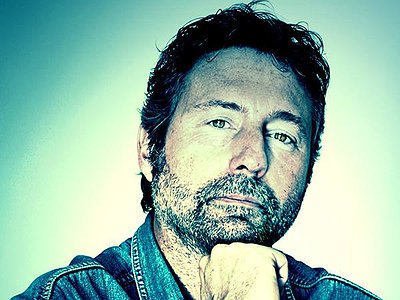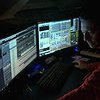Name: Laurent Schieber
Nationality: French
Occupation: Composer, Producer
Current Release: Ethereal
Recommendations:
In terms of musical art, without any hesitation, I would recommend the Mirage album by Klaus Schulze which was, for me, literally my musical trigger. It’s a work that deserves to be listened to several times in order to discover all its riches. Tons of credit to Klaus Schulze for this album, as well as for his entire career. In terms of literary art, I can suggest the French-speaking Jules Verne's "From the Earth to the Moon". It is a visionary narrative, a work that I particularly appreciate. During my childhood, I read many of his books and escaped far into my imagination.
Website / Contact: If you enjoyed this in-depth interview with Laurent Schieber aka Sequentia Legenda, his Facebook profile is an excellent source of updates and information – as is his personal website.
When did you start writing/producing music - and what or who were your early passions and influences? What what is about music and/or sound that drew you to it?
My passion for Berlin School began by absolute chance. I was only 16 years old at the time. On that momentous day, I discovered an album amongst my parents' vinyls - one that greatly grabbed my attention, especially due to the clean layout of its cover. A blue and green portrait, a title: Mirage, a name: Klaus Schulze. After examining both the graphic and editorial section, I decided to place the stylus on the record player in order to play the first side. From the first few seconds of listening, it was love at first sight - a true revelation. This was my musical trigger!
What attracted and even intrigued me the most when listening to this masterpiece, was the singular length of the songs, the fact that there were only two titles, the new sounds. The instruments and effects seemed to me to come from a whole new world. I began to listen repeatedly to the side A and B of the album. I started searching for other Klaus Schulze records in the music shops throughout my city. I spoke about the album to those around me, yet very few people knew who the musician was, much less the instrument known as a synthesiser. Shortly afterwards, I was taking music lessons with a teacher who owned a Rhodes, a Solina and even a famous Minimoog.
The solfeggio courses repelled me and quickly, my teacher came to understand that what really interested me was discovering the instrument. It is therefore with him that I discovered how to properly manipulate the synthesizer, as well as began learning sound synthesis - in this case, subtractive.
My parents finally gave in to my insistent requests and they agreed to finance the purchase of my very first monophonic synthesizer. In no time, the room in my parents' cellar became a small Ali Baba cave and many analogue instruments took their place here: ARP Odyssey, Oberheim Duo Voices, PS 3200 Korg, MS 20 and SQ 10 Korg - to only name the main ones.
For most artists, originality is first preceded by a phase of learning and, often, emulating others. What was this like for you? How would you describe your own development as an artist and the transition towards your own voice? What is the relationship between copying, learning and your own creativity?
As a first step, following the discovery of the Mirage album, I had listened intensively and analyzed the compositions of Klaus Schulze, Tangerine Dream or Jean-Michel Jarre. As a second step, I used the various synthesizers to discover the multiple technical and musical approaches in order to be capable of mastering the different sound syntheses. These were long and exciting periods of experimentation - a genuine learning of sonorous alchemy, a relentless manipulation of the potentiometers, hours of discovery.
At first, I recorded my compositions on tapes using a simple hi-fi tape recorder. Later, I recorded and mixed my work with a TEAC A-3340S 4-track recorder. I was trying to find a sonorous universe that was comparable to that of my models, close to the Berlin School.
My first sequences were created with both the Oberheim Two Voices as well as the Korg SQ10. Often, I would allow myself to go off into long hours of improvisation - sometimes until late at night and always in my parents' basement. This is how my personal style began to develop and little by little, I put my musical structure into practice. At that time, the sequencer already had a predominant position within my compositions. My own musical vision of the Berlin School began to take shape.
What were your main compositional- and production-challenges in the beginning and how have they changed over time?
The main challenge at the outset was finding the "right" sequence, the one that would make me "daydream", the loop that could grow within my composition. Afterwards came the search between the different pads and loops, in order to find the perfect balance and harmony between both said essential elements.
Even today, this work of dosing between sequences and pads is still carried on. I now have a methodology in order to transcribe the sound structure that passes through my head and thus, obtain a usable frame. The work is much the same, however with increased precision and a greater rigor. The sequences continue to remain one of the pillars of my creations and I commit a lot of time to setting up, to the accuracy of the loops and to the notes.
One of the big differences is that today, I create many co-existing loops that will complement one another, that will become more complex over the course of sound development and will grow together. I attempt to find harmony between the different elements of my music - in terms of volume, harmonics and stereophonic space. I am a demanding individual and at times, these steps can be time consuming. Ultimately, for me, everything is a question of dosage, sensitivity and emotions. When I isolate myself within my own world, I don’t see the time ticking by. Other times, I find myself in the role of a perfectionist and I therefore have to find the energy in order to end such a process and finalize the piece.
What was your first studio like? How and for what reasons has your set-up evolved over the years and what are currently some of the most important pieces of gear for you?
My startout studio was in one of the rooms within my parents' basement. My equipment consisted of analogue instruments, such as the ARP Odyssey, Oberheim Two Voices, Korg PS 3200, MS 20 and SQ 10, a Crumar Multiman S and a Roland RE201 echo chamber.
With the arrival of MIDI, I began transitioning from my analog synthesizers to the benefit of digital keyboards. It was at that moment that I would, for the first time, use software to manage my music - it was Pro24 Cubase installed on my Atari 1040 STF. I could now store my sounds and rework them according to my own will. It was possible for me to edit and save my compositions. It was a true revolution!
Today, I work with synths and virtual effects. The VSTs allow me a great flexibility of use and I manage to find sounds similar to those of my past synthesizers. I appreciate the Arturia collection, especially the Minimoog and the Modular Moog emulation.
How do you make use of technology? In terms of the feedback mechanism between technology and creativity, what do humans excel at, what do machines excel at?
In my opinion, technology must serve as a support to the work, an aid for the musician - yet without being omnipresent, so as not to hinder the creative process. We must find the middle ground between technology and man.
The strengths of my instruments are: almost unlimited creative possibilities, and the modifications as well as backups allow my work to be more serene. I especially appreciate the reliability of my VSTs.
The strengths of the human being: creativity without a doubt, the emotions that can be conveyed through our art, the sensitivity we place in musical balance, the soul that we are capable of infusing through passion and work in different projects. Ideally, there must be a symbiosis between machine and man in order to achieve a harmonious result.
Production tools, from instruments to complex software environments, contribute to the compositional process. How does this manifest itself in your work? Can you describe the co-authorship between yourself and your tools?
It's a symbiosis between my creative tools and myself. I know a few technical aspects of my instruments, of my effects, of Cubase. However, there is always a research phase, an experimentation period and finally a decision that belongs to me: that of finding my own path. Creativity has no limit in and of itself, the current tools allow me to find inspiring tracks of remarkable conception. There are automations put into place, I use certain effects (echo, reverberation) in order to obtain a specific atmosphere and others (chorus, flanger) to provide a certain depth and color to my instruments. Automations or effects on instruments offer many creative possibilities. Instruments, effects and software are one thing - I remain convinced that the final result will depend essentially on the sensitivity, the heart, the soul that the musician will infuse within their compositions. This is how I conceive my musical vision.
Collaborations can take on many forms. What role do they play in your approach and what are your preferred ways of engaging with other creatives through, for example, file sharing, jamming or just talking about ideas?
Collaboration is, in itself, a unique experience, an exchange, a communion. Two sound universes that meet.
I had the great pleasure of collaborating with the drummer, Tommy Betzler. His Berlin School experience (he played with Klaus Schulze in the 80 's) has been advantageous to me. The work was completed with great simplicity. I placed an mp3 file online with the overall instruments, allowing Tommy to immerse himself in my musical world, as well as a few basic instructions and certain explanations concerning the general atmosphere. Following such, I made a WAV file available, however without the rhythm part to allow him to work on it and equally to add his know-how. In return, Tommy provided me with the fruit of his work through WAV files. All I had to do then was conclude the final mix. That's how Tommy and I collaborated together on EXTENDED and most recently, on ETHEREAL.
Same goes for the collaboration with Jean-Luc Briançon (alias Kurtz Mindfields) for the title: OUT OF THE SILENCE. Again, the work was very enjoyable and efficient. Jean-Luc received my pre-mix, he added a few effects and solos. I, in return, was responsible of mixing our two sound universes with care and sensitivity. The result: the “French” Berlin School? :-)
Interviews / About
Fifteen Questions Interview with Laurent Schieber / Sequentia Legenda
The Daydream Sequence
Part 1

"I create many co-existing loops that will complement one another, that will become more complex over the course of sound development and grow together. I attempt to find harmony between the elements of my music - in terms of volume, harmonics and stereophonic space."


